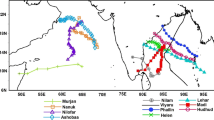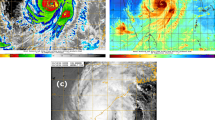Abstract
The present study investigates the performance of a regional numerical weather prediction model; namely, the Consortium for Small-scale Modelling (COSMO) in the prediction of the tropical cyclone (TC) trajectories for varying intensities of the storm. A total of 8 TCs formed over the Northern Indian Ocean from 2017 to 2019 are chosen for the evaluation of the COSMO model. The central pressure (\(P_\mathrm{Central}\)), pressure drop (\(\varDelta P\)), and maximum sustained surface wind speed (MSW) simulated by the COSMO model are validated against the concurrent observations from India Meteorological Department. The forecasted mean track errors are 95 km for a lead time of 24 h, whereas it was about 140 km for a lead time of 48 h. The mean initial positional error in identification of the storm was about 50 km. The intensity of a storm is underestimated in terms of \(\varDelta P\) and MSW, especially for a lead time of 0–24 h, whereas the model shows a consistent overestimation for a lead time of more than 24 h. During the initial stage of a storm, when its intensity is categorized as a Deep Depression, we notice a maximum amount of uncertainty in the prediction of cyclone track. The COSMO model yields improved predictability of the tracks for storms categorized as Very Severe Cyclonic Storms. As the intensity of a storm increases from a Deep Depression to a Very Severe Cyclonic Storm, the track errors associated with model simulations tend to decrease. Results of the present study illustrate the predictability of TCs from COSMO in terms of the trajectory and intensity of the storm.






Similar content being viewed by others
References
Albert J, Bhaskaran PK (2020) Optimal grid resolution for the detection lead time of cyclogenesis in the north Indian Ocean. J Atmos Sol Terr Phys 204:105289. https://doi.org/10.1016/j.jastp.2020.105289
Anurose TJ, Subrahamanyam DB (2015) Evaluation of ABL parametrization schemes in the COSMO, a regional non-hydrostatic atmospheric model over an inhomogeneous environment. Model Earth Syst Environ 1:38. https://doi.org/10.1007/s40808-015-0045-y
Baldauf M, Seifert A, Förstner J, Majewski D, Raschendorfer M, Reinhardt T (2011) Operational convective-scale numerical weather prediction with the COSMO model: description and sensitivities. Mon Weather Rev 139(12):3887–3905. https://doi.org/10.1175/MWR-D-10-05013.1
Bhaskar Rao DV, Hari Prasad D, Srinivas D (2009) Impact of horizontal resolution and the advantages of the nested domains approach in the prediction of tropical cyclone intensification and movement. J Geophys Res Atmos 114:D11106. https://doi.org/10.1029/2008JD011623
Bhatla R, Raj R, Mall R, Shivani (2020) Tropical cyclones over the north Indian ocean in changing climate, vol 5. Wiley, Chap, pp 63–76. https://doi.org/10.1002/9781119359203.ch5
Chutia L, Pathak B, Parottil A, Bhuyan PK (2019) Impact of microphysics parameterizations and horizontal resolutions on simulation of “Mora” tropical cyclone over Bay of Bengal using numerical weather prediction model. Meteorol Atmos Phys 131:1483–1495. https://doi.org/10.1007/s00703-018-0651-0
Cruz FT, Narisma GT (2016) WRF simulation of the heavy rainfall over metropolitan Manila, Philippines during tropical cyclone Ketsana: a sensitivity study. Meteorol Atmos Phys 128:415–428. https://doi.org/10.1007/s00703-015-0425-x
Dube SK, Rao AD, Sinha PC, Murty TS, Bahulayan N (1997) Storm surge in the Bay of Bengal and Arabian Sea: the problem and its prediction. Mausam 48(1):283–304
Dube A, Ashrit R, Kumar S, Mamgain A (2020) Improvements in tropical cyclone forecasting through ensemble prediction system at NCMRWF in India. Tropical Cyclones Res Rev 9(2):106–116. https://doi.org/10.1016/j.tcrr.2020.04.003
Emanuel K (2003) Tropical cyclones. Ann Rev Earth Planetary Sci 31(1):75–104. https://doi.org/10.1146/annurev.earth.31.100901.141259
Fletcher RD (1955) Computation of maximum surface winds in hurricanes. Bull Am Meteorol Soc 36(6):247–250
Fotso-Kamga G, Fotso-Nguemo TC, Diallo I, Yepdo ZD, Pokam WM, Vondou DA, Lenouo A (2020) An evaluation of COSMO-CLM regional climate model in simulating precipitation over central Africa. Int J Clim 40(5):2891–2912. https://doi.org/10.1002/joc.6372
Ganesh S, Sahai A, Abhilash S, Joseph S, Dey A, Mandal R, Chattopadhyay R, Phani MK (2018) A new approach to improve the track prediction of tropical cyclones over north Indian Ocean. Geophys Res Lett 45(15):7781–7789. https://doi.org/10.1029/2018GL077650
IMD-RSMC Frequently asked questions (2021) Frequently asked questions on tropical cyclones. IMD, New Delhi. http://www.rsmcnewdelhi.imd.gov.in/images/pdf/cyclone-awareness/terminology/faq.pdf. Accssed: 14 January 2021
Jacobsen I, Heise E (1982) A new economic method for the computation of the surface temperature in numerical models. Beit Phy Atmos 55(2):128–141
Kumar P, Kishtawal CM, Pal PK (2015) Impact of ECMWF, NCEP, and ECMRWF global model analysis on the WRF model forecast over Indian region. Theor Appl Clim 127:143–151. https://doi.org/10.1007/s00704-015-1629-1
Kumar S, Lal P, Kumar A (2020) Turbulence of tropical cyclone “Fani” in the Bay of Bengal and Indian subcontinent. Nat Hazards 103:1613–1622. https://doi.org/10.1007/s11069-020-04033-5
Kurowski MJ, Wojcik DK, Ziemianski MZ, Rosa B, Piotrowski ZP (2016) Convection-permitting regional weather modeling with COSMO-EULAG: compressible and anelastic solutions for a typical westerly flow over the Alps. Mon Weather Rev 144(5):1961–1982. https://doi.org/10.1175/MWR-D-15-0264.1
Langmack H, Fraedrich K, Sielmann F (2012) Tropical cyclone track analog ensemble forecasting in the extended Australian basin: NWP combinations. Q J R Meteorol Soc 138(668):1828–1838. https://doi.org/10.1002/qj.1915
Mesinger F, Veljovic K (2020) Topography in weather and climate models: Lessons from cut-cell Eta vs. European Centre for Medium-Range Weather Forecasts experiments. J Meteorol Soc Japan Ser II 98(5):881–900. https://doi.org/10.2151/jmsj.2020-050
Mishra SP, Sethi KC, Mishra DP, Siddique M (2019) Pre-monsoon cyclogenesis over Bay of Bengal. Int J Recent Tec Engg 8(2):4895–4908. https://doi.org/10.35940/ijrte.B3694.078219
Mohanty UC, Gupta A (1997) Deterministic methods for prediction of tropical cyclone tracks. Mausam 2:252–272
Mohanty S, Nadimpalli R, Mohanty UC, Mohapatra M, Sharma A, Das AK, Sil S (2020) Quasi-operational forecast guidance of extremely severe cyclonic storm Fani over the Bay of Bengal using high-resolution mesoscale models. Meteorol Atmos Phys. https://doi.org/10.1007/s00703-020-00751-4
Mohapatra M, Bandyopadhyay B, Tyagi A (2011) Best track parameters of tropical cyclones over the north Indian Ocean: a review. Nat Hazards 63:1285–1317. https://doi.org/10.1007/s11069-011-9935-0
Mohapatra M, Nayak DP, Bandyopadhyay BK (2012) Evaluation of cone of uncertainty in tropical cyclone track forecast over north Indian ocean issued by India Meteorological Department. Tropical Cyclones Res Rev 1(3):331–339. https://doi.org/10.6057/2012TCRR03.02
Mohapatra M, Nayak DP, Sharma RP, Bandyopadhyay BK (2013) Evaluation of official tropical cyclone track forecast over north Indian ocean issued by India Meteorological Department. J Earth Syst Sci 122(3):589–601. https://doi.org/10.1007/s12040-013-0291-1
Mukhopadhyay P, Taraphdar S, Goswami B (2011) Influence of moist processes on track and intensity forecast of cyclones over the north Indian ocean. J Geophy Res Atmos 116:D05116. https://doi.org/10.1029/2010JD014700
Murav’ev A, Kiktev D, Bundel’ A, Dmitrieva T, Smirnov A (2015) Verification of high-impact weather event forecasts for the region of the sochi-2014 olympic games. part I: Deterministic forecasts during the test period. Russ Meteorol Hydrol 40:584–597. https://doi.org/10.3103/S1068373915090034
Nadimpalli R, Srivastava A, Prasad VS, Osuri KK, Das AK, Mohanty UC, Niyogi D (2020) Impact of INSAT-3D/3DR radiance data assimilation in predicting tropical cyclone Titli over the Bay of Bengal. IEEE Trans Geosci Remote Sens 58(10):6945–6957. https://doi.org/10.1109/TGRS.2020.2978211
Osuri KK, Mohanty UC, Routray A, Mohapatra M, Niyogi D (2013) Real-time track prediction of tropical cyclones over the north Indian ocean using the ARW model. J Appl Meteorol Clim 52(11):2476–2492. https://doi.org/10.1175/JAMC-D-12-0313.1
Ritter B, Geleyn JF (1992) A comprehensive radiation scheme for numerical weather prediction models with potential applications in climate simulations. Mon Weather Rev 120(2):303–325. https://doi.org/10.1175/1520-0493(1992)120$<$0303:ACRSFN$>$2.0.CO;2
Roshny S, Subrahamanyam DB, Anurose TJ, Ramachandran R (2018) Impact analysis of dynamical downscaling on the treatment of convection in a regional NWP model - COSMO: a case study during the passage of a very severe cyclonic storm “Ockhi”. Nat Haz Earth Syst Sci Disc 2018:1–26. https://doi.org/10.5194/nhess-2018-288
Samiksha V, Vethamony P, Antony C, Bhaskaran P, Nair B (2017) Wave-current interaction during Hudhud cyclone in the Bay of Bengal. Nat Haz Earth Syst Sci 17:2059–2074. https://doi.org/10.5194/nhess-17-2059-2017
Schättler U, Doms G, Schraff C (2018) A description of the nonhydrostatic regional COSMO-Model. DWD Report: User’s Guide COSMO V5.05:175 pp
Sharma SK, Misra SK, Singh JB (2020) The role of GIS-enabled mobile applications in disaster management: a case analysis of cyclone Gaja in India. Int J Info Manag 51:102030. https://doi.org/10.1016/j.ijinfomgt.2019.10.015
Shrestha P, Dimri AP, Schomburg A, Simmer C (2015) Improved understanding of an extreme rainfall event at the Himalayan foothills: a case study using COSMO. Tellus A Dyn Meteorol Ocean 67(1):26031. https://doi.org/10.3402/tellusa.v67.26031
Singh K, Bhaskaran PK (2017) Impact of PBL and convection parameterization schemes for prediction of severe land-falling Bay of Bengal cyclones using WRF-ARW model. J Atmos Sol Terr Phys 165–166:10–24. https://doi.org/10.1016/j.jastp.2017.11.004
Singh K, Bhaskaran PK (2018) Impact of lateral boundary and initial conditions in the prediction of Bay of Bengal cyclones using WRF model and its 3D-VAR data assimilation system. J Atmos Sol Terr Phys 175:64–75. https://doi.org/10.1016/j.jastp.2018.05.007
Singh R, Kishtawal C, Pal P, Joshi P (2012) Improved tropical cyclone forecasts over north Indian ocean with direct assimilation of AMSU-A radiances. Meteorol Atmos Phys 115:15–34. https://doi.org/10.1007/s00703-011-0165-5
Subrahamanyam DB, Ramachandran R, Nalini K, Paul FP, Roshny S (2019) Performance evaluation of COSMO numerical weather prediction model in prediction of Ockhi—one of the rarest very severe cyclonic storms over the Arabian sea: a case study. Nat Hazards 96:431–459. https://doi.org/10.1007/s11069-018-3550-2
Subrahamanyam DB, Roshny S, Paul FP, Anurose TJ, Ramachandran R (2020) Impact of a very severe cyclonic storm “Ockhi” on the vertical structure of marine atmospheric boundary layer over the Arabian Sea. Bull Atmos Sci Tech. https://doi.org/10.1007/s42865-020-00020-7
Tang BH, Fang J, Bentley A, Kilroy G, Nakano M, Park MS, Rajasree VPM, Wang Z, Wing AA, Wu L (2020) Recent advances in research on tropical cyclogenesis. Tropical Cyclones Res Rev 9:87–105. https://doi.org/10.1016/j.tcrr.2020.04.004
Tiedtke M (1989) A comprehensive mass flux scheme for cumulus parameterization in large-scale models. Mon Weather Rev 117(8):1779–1800. https://doi.org/10.1175/1520-0493(1989)117$<$1779:ACMFSF$>$2.0.CO;2
Zängl G, Reinert D, Rípodas P, Baldauf M (2015) The icon (icosahedral non-hydrostatic) modelling framework of DWD and MPI-M: description of the non-hydrostatic dynamical core. Q J R Meteorol Soc 141(687):563–579. https://doi.org/10.1002/qj.2378
Zhou R, Gao W, Zhang B, Chen Q, Liang Y, Yao D, Han L, Liao X, Li R (2017) A new prediction model of daily weather elements in hainan province under the typhoon weather. Meteorol Atmos Phys 131:1–20. https://doi.org/10.1007/s00703-017-0567-0
Acknowledgements
The NWP model COSMO is developed by Deutscher Wetterdienst (DWD, the German Weather Service) and its source code can be obtained under the terms and conditions detailed in the COSMO model’s website, i.e., http://www.cosmo-model.org/). Space Physics Laboratory (SPL) of Vikram Sarabhai Space Center has a scientific license for usage of COSMO model for research applications. We are thankful to the DWD for making the initial and lateral boundary conditions of ICON available to us for the present study. We express our sincere gratitude to Drs. Ulrich Schättler and Detlev Majewski, and other colleagues from DWD for their continuous support and suggestions for the setting up of COSMO model and its smooth functioning at SPL. The Best Track data of all the cyclones in the present study are taken from the e-Atlas of India Meteorological Department, and we duly thank them for making the data available in public domain. We are also very much thankful to anonymous reviewers for their constructive criticism of the manuscript. One of the authors, FPP, is thankful to the Indian Space Research Organisation for the financial assistance through the ISRO Research Fellowship for his Ph.D.
Author information
Authors and Affiliations
Corresponding author
Ethics declarations
Conflicts of interest
The authors declare that they have no conflict of interest.
Additional information
Responsible Editor: Fedor Mesinger.
Publisher's Note
Springer Nature remains neutral with regard to jurisdictional claims in published maps and institutional affiliations.
Rights and permissions
About this article
Cite this article
Paul, F.P., Subrahamanyam, D.B. Prediction of tropical cyclone trajectories over the Northern Indian Ocean using COSMO. Meteorol Atmos Phys 133, 789–802 (2021). https://doi.org/10.1007/s00703-021-00782-5
Received:
Accepted:
Published:
Issue Date:
DOI: https://doi.org/10.1007/s00703-021-00782-5




